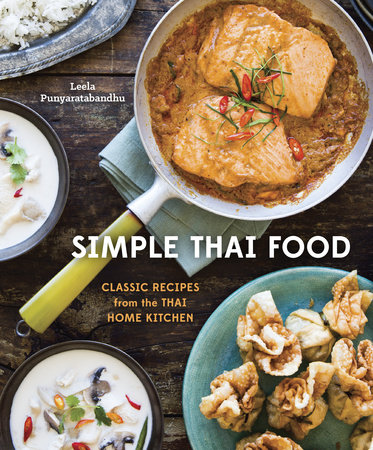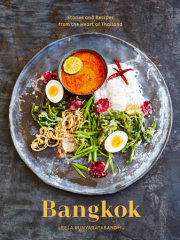Introduction When I started my website, shesimmers.com, in 2008, I had no idea where it would lead. At the time, my only goal was to document the best, most tried-and-true Thai recipes from my mother’s cookbook collection. She had passed away a few weeks earlier, and cooking, photographing, and sharing the recipes was my way of honoring her memory.
My mother started sending her cookbooks to me in the early 2000s, when I moved to Chicago for school. Although I continued to return frequently to my hometown of Bangkok, Mom was concerned that I would forget how to cook the dishes that I grew up with—or, worse yet, that I would forget how Thai food in Thailand tastes.
She need not have worried. Cooking from Mom’s collection helped me stay connected to my roots, and blogging about Thai food on my website inspired me to share my love of Thai history, culture, and language—as well as different food spots in the country—with others.
Today, I write about Thai food and culture not only for my website but also for other online and print publications, and I love interacting with my readers, most of whom are non-Thais living in the West. What I have learned is that many of them—too many—are filled with dread at the thought of trying to make their favorite Thai dishes at home.
I sympathize with them. Acquiring the fresh ingredients necessary to make a classic Thai dish entirely from scratch is often either impossible or too costly to be worth the effort. At the same time, many American cooks feel that cracking open a can of Thai curry paste is cheating. They worry that if they take shortcuts, an angry Thai grandmother will jump out from behind the nearest potted plant with a stun gun.
Although it is true that several Thai dishes absolutely require that you invest time and money in sourcing hard-to-find ingredients, such as kaffir lime and galangal, to replicate their flavors faithfully, many dishes that are just as traditional are made with everyday ingredients that are stocked in most markets.
My goal with Simple Thai Food is to show readers how easy it is to re-create traditional flavors—and the classic Thai dishes I grew up eating—at home. Once you have built a pantry of essential Thai ingredients (see page 3), whipping up delicious tom yam kung (page 86), drunkard’s noodles (page 133), or cashew chicken (page 61) takes less time and is more affordable than calling up your local takeout joint.
In choosing which recipes and methods to include in this book, I have unwaveringly adhered to three guiding principles: foundation, feasibility, and fun. The alliteration, trust me, is accidental.
Foundation. This book is rooted in the food that I grew up eating and cooking in Bangkok, where I was born and raised. The recipes represent Thai food as I have experienced it in my life. These are dishes that I am proud to serve to my family and friends, dishes that I know will not make them back slowly away from the table with their hands up, demanding to know what on earth this unknown, made‑up fare is. This is my foundation. This is the food I cook when I am longing for the taste of home.
None of the recipes is unique to this book. In other words, my goal is not to invent new Thai-inspired recipes but rather to guide you through the process of re-creating dishes that are well known in Thailand as well as in Thai restaurants in the United States. Because I was raised in Bangkok, my tastes naturally skew more toward the dishes I grew up eating. But today, with the gap between how Thai food is made in Thailand and how it is made elsewhere in the world narrowing with each passing year, the recipes in this book will not be foreign to anyone.
Feasibility. My goal is not only to faithfully re-create the food I love but also to ensure that Thai food fans everywhere can cook the dishes at home. That means that I have had to choose and adapt recipes for home cooks whose kitchens are not equipped with every tool necessary to make Thai dishes the traditional way, and I have had to offer substitutions for harder-to-find fresh Thai ingredients.
The unavailability of fresh ingredients is one problem that affects everyone from veteran chefs to novice cooks. But the good news is that as Thai food becomes more popular, more and more Thai pantry staples, such as tamarind pulp, coconut cream, and curry pastes, are available at well-stocked grocery stores. Better yet, if you live in an area with an Asian market, you can often find affordable, Thai-imported versions of these and other essentials, such as thin soy sauce, dark sweet soy sauce, and dried shrimp. If you do not have access to an Asian grocer, your best shot for finding some ingredients will be to order them online, and I have listed some reliable online sources on page 217. But because some of you may be hesitant to take the plunge into online grocery shopping, I have provided many ingredient substitutions, particularly for fresh produce items (Chinese broccoli, Chinese water morning glory, long beans) that are hard to locate in many areas of the United States.
Fun. Cuisine exists to serve us, not the other way around, and cooking should be enjoyable. Some of the recipes in this book are ridiculously easy; some take a bit of effort. I have attempted to lay out the steps for every recipe in a way that makes them doable for even the novice cook. Complicated steps have been streamlined, and substitutions are suggested. None of the recipes requires any gadget or gizmo that you do not already have or cannot easily find.
--------------------------------
Herb-Baked Cashews met mamuang himma-phan op samunphrai I drink so little alcohol that the amount that I consume each year is barely enough to fill a soup bowl. And much of that is in the form of a wine cooler or a light beer. I just do not have a taste for alcohol. But all my friends and cousins love me because I am the perfect designated driver, the person who is willing to go sit with them at a bar in Bangkok and drink overpriced soda and nosh all night on the quintessential Thai bar snack, seasoned fried cashews. This is the baked version of those sweet-and-sour fried nuts, with a touch of herbal fragrance and a little bit of heat.
Makes 2-1/2 cups
1 pound raw whole cashews
2 tablespoons vegetable oil
1⁄4 cup freshly squeezed lime juice
Grated zest of 1 lime
1 tablespoon minced fresh cilantro leaves
1 tablespoon minced fresh mint leaves
1 tablespoon minced green onion, green part only
2 tablespoons honey
1 teaspoon salt
1 teaspoon red chile powder
Preheat the oven to 300°F. Line a large baking sheet with parchment paper or a silicone mat.
In a large bowl, combine all of the ingredients and mix well, making sure that the cashews are evenly coated with the seasonings. Spread the cashews in a single layer on the prepared baking sheet, leaving as much space as possible between them.
Bake the nuts, stirring them every 5 minutes, until golden brown, about 20 minutes. Remove from the oven and let cool completely on the baking sheet before serving or storing. The cashews can be stored in an airtight container at room temperature for up to 1 week. But trust me: they will be gone long before that.
Copyright © 2014 by Leela Punyaratabandhu. All rights reserved. No part of this excerpt may be reproduced or reprinted without permission in writing from the publisher.









